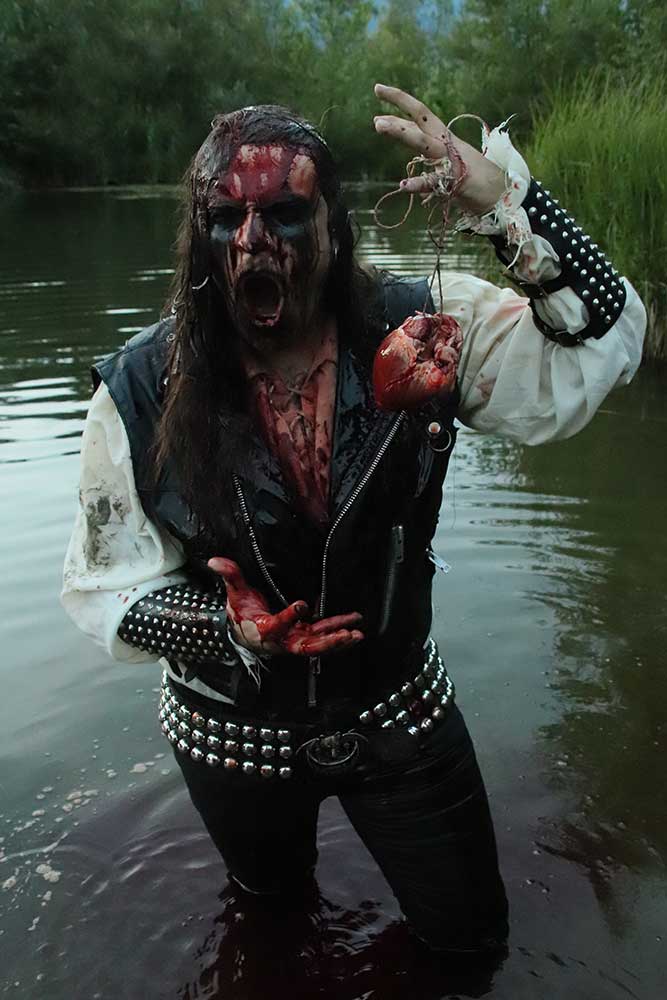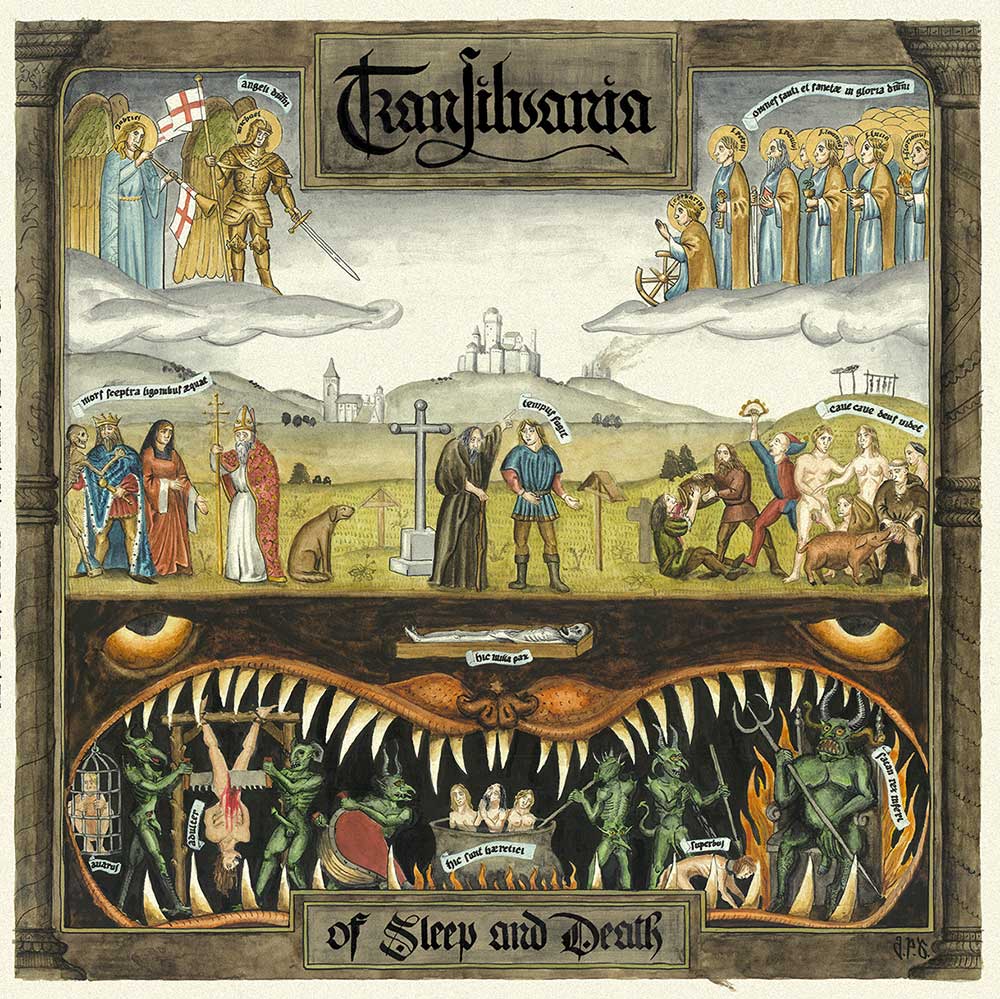Transilvania
2020-10-29
by Niklas Göransson
Transilvania is an Austrian black metal band heralding the ancient myths and legends which serve to remind us of both the frailty of our human condition and subsequent permanence of death.
– Although our songs have grown more extreme, I’d say the melodies, leads, and vocals are still typical for TRANSILVANIA – they conjure up a feeling known from our previous releases. Another change is that most of the material has become more complex, making it necessary to enhance the experience by merging the visual and musical aspects. Due to the slightly different approach to song-writing, our goal was to drag the listener even deeper into the darkness we’ve created. Mixing and mastering were handled by Marco of FLAMEKEEPER and The Devil’s Mark Studio; he implemented the musical concept of our album brilliantly, which clearly shows in the direction TRANSILVANIA has developed.
“Of Sleep and Death” is set for release by Invictus Productions on January 1, 2021. It remains to be seen if the Austrian quartet will be able to promote their new record with live shows this time around – which was not the case with the debut, “The Night of Nights” from 2018, seeing as how guitarist Mammon departed shortly following its release.
– It was extremely frustrating not being able to celebrate the debut like we wanted to; it’s nearly impossible to play our songs with only one guitar, so we had to cancel most of the release shows. A suitable replacement was found in mid-2017 when D.D. Stumpp of TRIUMPHANT joined us as session guitarist for live performances. It soon became apparent that he should become a full member of TRANSILVANIA. I had the pleasure of getting to know his musical ambitions during my time as live guitarist for TRIUMPHANT a few years earlier, which made it so much easier to introduce him to the way we work. Suddenly, we felt like a union again – especially in terms of playing live – which strengthened our decision to keep him in our ranks on a permanent basis.
Having regained their momentum, TRANSILVANIA immediately commenced song-writing for their second album, “Of Sleep and Death”.
– All of us were determined to leave behind us any weakness from the past and bring TRANSILVANIA to the next level. Out of this intention emerged a creative dispute which – while never on a personal level – led to many heated discussions about our future outward representation. An even bigger challenge was the task of projecting our concept onto the music. It’s mostly O. von Schwarzenberg and I who put the songs together, using riffs and melodies written either at home or spontaneously during rehearsal. For me, every song starts with a story in my head, accompanied by a special feeling. If the idea sticks with me long enough, my first step is to give it a name; only after that will I tell the other guys about my vision of how to express it through riffs, lyrics, and melodies. With “Of Sleep and Death”, each of us presented our ideas, which generated the tensions necessary to grow stronger as a band. Now, I see the whole process as a mental test of how far we can go together, and it seems we haven’t failed yet.

TRANSILVANIA places a lot of emphasis on a synchronised approach for music, aesthetics, and lyrics. P. Čachtice – bass and vocals – makes a salient point in that the feeling of an underground metal band is often dictated by its thematic content. For instance, a band like BESTIAL WARLUST is unlikely to have worked very well with the lyrics from ULVER’s “Bergtatt”.
– In my opinion, the lyrical themes should fit both the music and visual representation. This is one of the hardest steps in the creation of a new release and demands a lot from the artist’s creativity. From the listener’s perspective, any album – regardless of genre – is supposed to serve as a key to another world, and the responsibility of guiding him there lies on the musician. For example, playing an aggressive style with a lot of up-tempo riffing and fast drumming while singing about the solitude of melancholic landscapes would cast the whole band in a wrong light. The lyrical and musical expressions must complement each other; otherwise, it just doesn’t work. This does not necessarily mean that one style or genre is better than the other: I can enjoy either, as long as the concept is coherent.
P. describes the thematic content of “Of Sleep and Death” as mostly rooted in medieval folklore and myth. This would appear to be correct, as a swift perusal reveals vampires, ferrymen, lycanthropes, witches, and all manner of similar unsavoury characters.
– We wanted a concept capable of carrying our listeners deeper into the realm of the dead – for this purpose we used both well-known European iconography symbolising death as well as various notions of Heaven and Hell stemming from times of classical antiquity until now. Generally, our aim is to breathe new life into the undead characters of such tales. One legend that inspired me was the Three Living and the Three Dead: a popular poem during the middle ages with a lot of different interpretations. It was one of the first described meetings between living people and the undead, meant to make them aware of their human impermanence.
The Three Living and the Three Dead’ is a 13th-century legend known from both English and French sources. This tale is what’s called a memento mori: a reminder of the frailty of human existence and the inevitability of death. The story comes in many different variations, but the gist of the matter is a meeting between three living – often men of prosperity and power – and three dead. In one of the oldest known written versions, the mortals are represented by a duke, a count, and a prince who end up separated from their entourage during a boar hunt. Lost in the mist, they are confronted by a trio of walking corpses. Rather than wishing harm, the undead urge them to change their frivolous ways and lead a more worthy existence. ‘Such as I was you are, and such as I am you will be’, they warn, ‘wealth, honour and power are of no value at the hour of your death.’
– However, it’s wouldn’t be entirely accurate to say that our lyrical content is simply all about myths and medieval folklore. It’s perhaps more of an attempt to create new interpretations related to dark and unearthly topics from the past. The foremost inspiration isn’t actually tales or legends – but real-life truth. In Eastern Europe, some smalls villages were still celebrating the vampire heart ritual into the modern age. Graves of alleged vampires were dug up, the heart was removed from the dead body and burned under the night sky: finally, its ashes were then drunk with water. This also shows how the fear of revenants is still a factor to this day. One interesting topic we wrote about is the 13th-century requiem masses that were held for living people to evoke their death; this shows how closely medieval Christianity and magic worked together back then.

P. explains that the part of Austria TRANSILVANIA reside in is still very conservative in terms of values and religion. As such, the Catholic perceptions of death and damnation have been highly formative to their adult selves.
– Growing up around here, for various social reasons, you’re more or less forced to participate in all the Catholic rituals. During a young age, priests and religion teachers already treat you like a sinner: this can trigger feelings of guilt in your mind for no good reason. In addition, many churches in Tyrol have medieval fresco paintings showing death, Hell, and sin. One particular event in my childhood was a school visit to the chapel of the dead in my hometown, which preserves the skulls of fallen freedom fighters. Altogether, it was pathbreaking for my imagination of evil and an impression which probably won’t leave me until the end of my days. Besides that, various legends of the church, the cemetery, and many chapels have forever spoiled the idea of redemption from sins. For example, according to one of those myths, the well in front of the church in my hometown was originally a gate to Hell where Father Death dragged sinners into damnation. I still visit these places; not for religious reasons, but more because of the twilight of ingrained Catholicism and the sinister tales surrounding them. The visual concept of “Of Sleep and Death” is based on these representations in our environment and what society feared back then – and some still do – as well as how this affected their everyday life.
You are talking about the rather striking cover artwork, I presume?
– Yes. We already had the idea to use artwork in this medieval-like style since the very early days of TRANSILVANIA. The artist, Jaime Pascual Sanz, grew up in almost the same type of Catholic environment we did, which helped the collaboration enormously. He came up with a lot of suggestions of how to portray sins, double standards, infidelity, greed, jealousy and burning kingdoms. All this between the forces of Heaven and Hell. But the most important thing is the revenant lurking in the middle of the painting, symbolising the awakening menace by people’s behaviour – and the resulting damnation.



